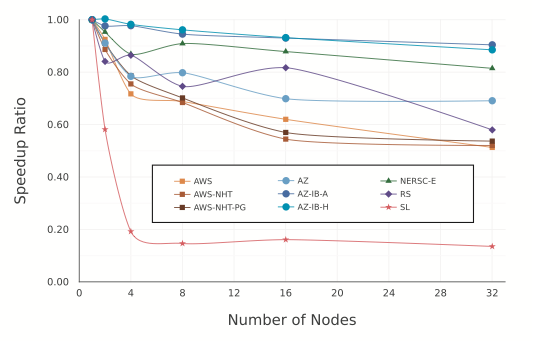The “when will clouds be ready for HPC” question has ebbed and flowed for years. It seems clear that for at least some workloads and on some clouds, the answer is now. HPC cloud specialist Nimbix, for example, focuses on providing fast interconnect, large memory, and heterogeneous architecture specifically tailored for HPC. The goliath public clouds have likewise steadily incorporated needed technology and (perhaps less decisively) pricing options.
A new study posted on arXiv.org last week – Comparative benchmarking of cloud computing vendors with High Performance Linpack – authored by Exabyte.io, an admittedly biased source, reports the answer is an unambiguous yes to the question of whether popular clouds can accommodate HPC and further examines some of the differences between a few of the major players.
“For high performance computing (HPC) workloads that traditionally required large and cost-intensive hardware procurement, the feasibility and advantages of cloud computing are still debated. In particular, it is often questioned whether software applications that require distributed memory can be efficiently run on ”commodity” compute infrastructure publicly available from cloud computing vendors,” write the authors, Mohammad Mohammadi, Timur Bazhirov of Exabyte.io.
“We benchmarked the performance of the best available computing hardware from public cloud providers with high performance Linpack. We optimized the benchmark for each computing environment and evaluated the relative performance for distributed memory calculations. We found Microsoft Azure to deliver the best results, and demonstrated that the performance per single computing core on public cloud to be comparable to modern traditional supercomputing systems.
“Based on our findings we suggest that the concept of high performance computing in the cloud is ready for a widespread adoption and can provide a viable and cost-efficient alternative to capital-intensive on- premises hardware deployments.”
Exabyte.io is a young company building a cloud-based environment to assist organizations with materials design – hence it has a horse in the race. Company marketing info on its website states, “Exabyte.io powers the adoption of high-performance cloud computing for design and discovery of advanced materials, devices and chemicals from nanoscale. We combine high fidelity simulation techniques, large-scale data analytics and machine learning tools into a hosted environment available for public, private and hybrid cloud deployments.”
Leaving its interest aside the study is interesting. Here’s a list of the cloud offerings evaluated:
- Amazon Web Services (AWS)
- Microsoft Azure
- Rackspace
- IBM Softlayer
- National Energy Research Scientific Computing Center (NERSC)
The benchmarking was done using the High Performance Linpack (HPL) program, which solves a random system of linear equations, represented by a dense matrix, in double precision (64 bits) arithmetic on distributed-memory computers. “It does so through a two-dimensional block- cyclic data distribution, and right-looking variant of the LU factorization with row partial pivoting.” It is a portable and freely available software package.
Three different AWS scenarios were tested including– hyper-threaded, non-hyper-threaded, and non-hyper-threaded with placement groups. On Azure, three different instance types were used, F-series, A-series, and H-series. Compute1-60 instances were used on Rackspace. The benchmark was also run on NERSC Edison supercomputer with hyper-threading enabled. Edison, of course, is a Cray XC30, with a peak performance of 2.57 PFLOPS, 133,824 compute cores, 357 terabytes of memory, and 7.56 petabytes of disk, holding number 60 rank on the top500. Specific configurations shown below.
In many cases the performances were quite similar but each also had strengths and weaknesses. For example, network saturation at scale and slower processor clock speeds affected IBM Softlayer’s performance according to the study. The authors also noted: “AWS and Rackspace show a significant degree of parallel performance degradation, such that at 32 nodes the measured performance is about one-half of the peak value.”
The brief paper is best read in full for the details. The performance data for each of the clouds is presented. Below is a summary figure of cloud performances.

On balance, argue the authors, “Our results demonstrate that the current generation of publicly available cloud computing systems are capable of delivering comparable, if not better, performance than the top-tier traditional high performance computing systems. This fact confirms that cloud computing is already a viable and cost-effective alternative to traditional cost- intensive supercomputing procurement.”
Here is a link to the paper on arXiv.org: https://arxiv.org/pdf/1702.02968.pdf






























































